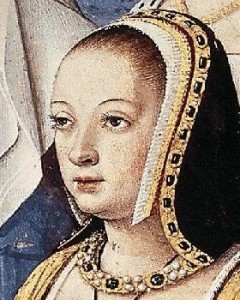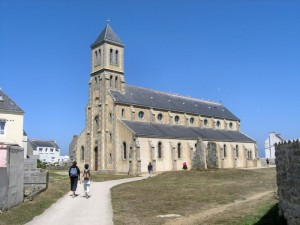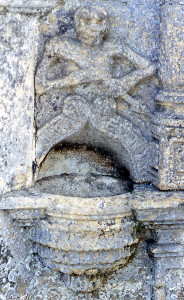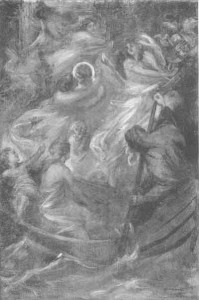While the Nine Old Gods of Brittany are my own invention, they were built on a number of historical, geographical, and ancient theological precedents, so I thought I’d share some of those here for those of you who are curious to know what my inspirations for world of His Fair Assassin were.
As the Catholic Church struggled to gain acceptance among people who were reluctant to let go of their own pagan beliefs, it made a conscious decision to actively subsume those beliefs into Christianity, white washing and Christianizing them along the way. They felt it would make it easier for people to accept the new religion if they could recognize parts of their old beliefs in it.
Brittany was also home to the last remaining group of druidesses, called the Gallinezae, who were said to possess mysterious power. Additionally, Brittany had nine bishoprics, or districts, that were based on the nine earlier Celtic tribes who inhabited the land.
Since Brittany was originally inhabited by the Celtic tribes, I built the mythology of His Fair Assassin on a Celtic foundation. It’s also important to note that I drew from Continental Celtic roots for my mythology rather than the Irish Celts.
Trying to accurately recreate any Celtic beliefs is tricky however, because the Celts themselves did not create any written record of their beliefs or practices; it was all passed along through the oral tradition. In fact, druids in training were required to study for twenty years in order to learn all their lore and history by committing it to memory.
Consequently, nothing of the Celtic religion or spiritual beliefs and practices was written down until they were invaded by Rome. In addition to viewing the Celts practices with scorn, the Romans often interpreted other pantheons according to their own, thus a mother goddess must be equated with Zeus’s wife Hera, or a god of the Underworld with Hades, etc. This Interpretatio romana colored everything we knew about Celtic practices up until fairly recently when improved archaeological techniques and methods began revealing a more complete and accurate picture. The funny thing is though, by the middle ages the myth and folklore of these earlier Celts would have been very much written over and ‘tainted’ by the Romanization of those myths, so that those living in the 15th century would have been more familiar with this Romanized version. Since I set the story in that timeframe, I wanted to be true to that worldview rather than our own, more knowledgeable one.
Here is a list of the Nine Old Gods of Brittany along with their Roman/Greek or Celtic influences/inspiration:
Saint Mortain – god of death. The Celtic equivalent to Dis Pater, the Romanized Celtic god of death, with some similarities to the Welsh Arawn. Greek and Roman counterparts would be Pluto and Hades, but the Celtic Dis Pater had other aspects to him that tied him to older beliefs that enveloped not only the underworld, but the entire cycle of life and death. Also inspired by the Breton figure of personified death, the Ankou.
Dea Matrona – Gaulish mother goddess, responsible for the earth’s bounty. Similar to the Celtic Anu or Ana.
Saint Amourna – daughter of Dea Matrona and one of the twin goddesses of love. Amourna is the gentle aspect of love. The Celtic pantheon had no goddess of love per se, so she definitely has aspects of Aphrodite or Venus. However, the idea of twin sister goddesses representing the dual aspects of love was my own invention.
Saint Arduinna – daughter of Dea Matrona and goddess of love’s sharp bite, protector of virgins. There was a Celtic goddess Arduinna who was a goddess of the forest. Boars, highly revered by the Celts, were sacred to her. Similar to the Gallo-Roman Diana.
Saint Mer – goddess of the sea. While there is no known Celtic god of the sea, there were many deities of springs and lakes, most of whom were goddesses so I decided to make the deity of the sea in my world in keeping with the feminine representations the Celts seemed to favor.
Saint Camulos – god of battle and warriors. Wears a corona of oak leaves and ram’s horns. The Romans equated him with Mars, but I also drew slightly on the cult of Mithros.
Saint Brigantia – goddess of wisdom; brought medicine and healing knowledge to mankind. Based on the Celtic goddess Bridget, who is one of the most widely known pagan goddesses to have become a saint. Her Greek and Roman counterparts would be Athena and Minerva.
Saint Cissonius – god of crossroads and travelers. I took the Celtic Cissonius, god of trade, and expanded on it a bit.
Saint Salonius – god of mistakes and patron saint of bastards. Ah, this is my most historically tenuous god. I have always been a fan of the trickster god who appears in so many pantheons, and I saw a fleeting entry on the Wikipedia Celtic Gods and Goddesses page that reference Salonius, god of mistakes. Alas, when I later went to reference it, the entry was gone and I couldn’t even find it in the Google cache search. Although it seems fitting that my god of mistakes might have been born of one of my own.




 Welcome. I'm Robin LaFevers.
Welcome. I'm Robin LaFevers.